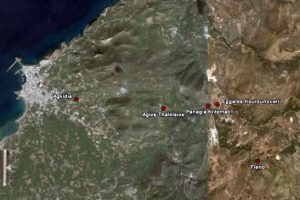Present Status
Nowadays, the most important parts of the aqueduct have been restored in order to be accessible to visitors, thanks to the collaboration between the specialised scientists and the local authorities, but also thanks to the understanding and cooperation of the land owners whose properties coincided with the selected sites for the exposure of the aqueduct.

Hydria Virtual Museum
In fact, the University of Athens has recently excavated, studied and enhanced five sites of the total complex of the aqueduct, namely:
a) Flerio: Quarries with two half finished statues, a sanctuary near the spring, and the entrance to the tunnel of the aqueduct are exhibited.

Hydria Virtual Museum
b) Katsoprini – Leftera – Emazos: Parts of all the phases of the aqueduct are exhibited.
c) Kritomati (or Louroi) – Agios Thaleos: Parts of the later Roman phases of the aqueduct are exhibited.
d) Agios Stefanos: Ruins of an early Christian Church and parts of the aqueduct are exhibited.
e) Funtana and the tower in the castle of Chora: ancient and more recent water supply works are exhibited.








